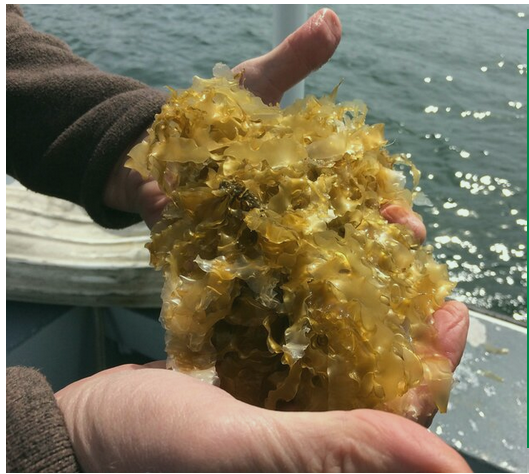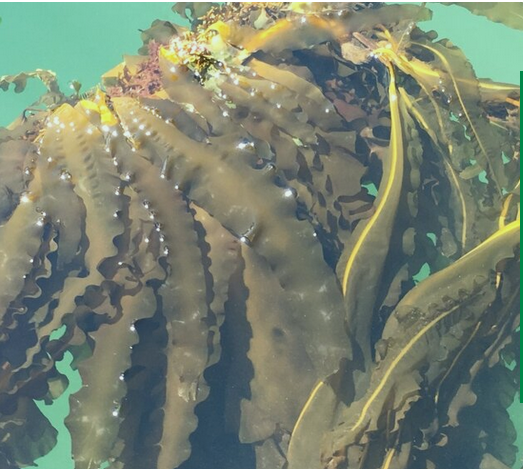Kelp might be the right crop at the right time in the current climate crisis
By Cynthia Drummond / ecoRI News contributor

Azure Cygler owns and operates Rhody Wild Sea Gardens,
which farms kelp. (Courtesy photo))
Farmed
kelp represents a tiny share of Rhode Island’s aquaculture revenue, but Azure
Cygler believes that as more people recognize its nutritional and environmental
benefits, its popularity will grow.
Cygler,
an extension specialist at the University of Rhode Island, formed her
company, Rhody Wild Sea Gardens LLC, in 2020 and
grew her first kelp crop in 2021.
“I’m
in the East Passage of Narragansett Bay, and I’m sub-leasing from a [oyster]
farmer there,” she said. “I have what I hope to be around 7,000 pounds this
year harvesting, wet weight, of kelp — what I hope to be. I don’t know yet.”
Sugar kelp, Saccharina latissima, is
a brown marine algae that resembles lasagna noodles and often washes up on R.I.
beaches. Its value as a food is undisputed in Asia, where it is widely
cultivated for its vitamins, minerals and fiber. It is also used as a sweetener
and as a thickener for foods and even cosmetics. It has been used for millennia
as an organic fertilizer.
The
benefits of kelp are largely unrecognized in the United States, but Cygler and
others believe that its moment may be coming soon. Because kelp stores carbon
and removes excess nutrients from seawater, it might be the right crop at the
right time in the current climate crisis.

Sugar kelp, Saccharina latissima, often washes up on R.I. beaches.
(Azure Cygler)
“Carbon capture — there’s so many environmental benefits that kelp provides, and that’s why I got into it, to try to figure out a way to get us farmers, not just kelp, but oyster aquaculture into that space, to be able to receive financial benefits to our farmers because we’re actually a good to the ecosystem,” she said.
“Currently, there’s not really an opportunity to do that. There’s
obviously carbon capture, carbon offset trading programs out there for
land-based farms, so I’m trying to figure out a way for that to apply to us.”
Cygler
also noted that because it grows so quickly, kelp captures more carbon than
woodlands.
“Kelp
captures 20 times more carbon than land-based forests per acre, because it
grows so fast,” she said. “But for me, it’s not just the carbon aspect, it’s
all the other ecosystem services. It captures nitrogen, phosphorus, all the
sort of runoff nutrients, and it also provides a really great storm buffer in
the winter. It’s a habitat for species in the area — there’s just a lot of
really good water quality benefits.”
Kelp
also has potential for use as a more environmentally friendly animal feed.
Methane, much of it emitted by cattle, is a greenhouse gas and marine algae
reduces methane.
“There’s an incredible potential for using kelp and other marine algae for animal feed, to reduce methane,” Cygler added. “There’s a lot of great science happening where they’ve fed it to cows. A species of red algae in particular has reduced the methane emissions by 70 to 90 percent.”
The
Coastal Resources Management Council regulates aquaculture in the state and
publishes the annual Aquaculture in Rhode Island report.
The most recent report, issued in 2020, states that of the 84 aquaculture
operations in Rhode Island, only two are kelp farms.
While
the number of kelp growers has declined from about six a few years ago, CRMC
has received one application to expand a seasonal kelp growing operation in the
Harbor of Refuge. In 2020, the agency rejected an application for a 10-acre
kelp farm off Napatree Point in Westerly. The applicant hoped the farm would
improve water quality, but opponents said it would disturb waterfowl, impede
fishing and mar the appearance of the popular recreation area.
Aquaculture
is a R.I. success story, with products valued at more than $4.2 million in
2020. Oysters are by far the most widely grown product, but the pandemic hit
the industry hard in 2020 with restaurant closures, and the total value of the
national market for farmed shellfish declined by more than 32%.

Kelp stores carbon and removes excess nutrients from seawater.
(Azure Cygler)
Although the total area in R.I. leased for aquaculture is less than 350 acres, conflicts are not uncommon between growers, homeowners, and recreational and commercial fishermen.
Kelp farming takes place during the winter, reducing the potential
for conflict.
While
state regulations are the same for kelp and shellfish farms, CRMC spokeswoman
Laura Dwyer said the season for growing kelp is much shorter.
“The
aquaculture regulations apply to both, though each application is evaluated on
its own merit,” she wrote in an email. “The seasonal kelp-only operations are
limited to Nov. 1 to May 1 by stipulation on the assent. This has to do with
the growing cycle of kelp but also all gear is removed in the off-season to
avoid any conflicts.”
Cygler
said she had experienced her own challenges as she tried to start her kelp
farm.
“A
lot of the use conflicts we see with the year-round aquaculture crops, and I
think kelp can really avoid that, although there’s still opposition,” she said.
“I tried to get my own lease and was met with much opposition, so in order to
just kind of get a jump-start, I’m working with another farmer at the moment.
He’s an oyster farmer and he’s allowed to grow kelp. It’s permitted. He’s just
never done it before, so we’re partnering on that.”
Unlike
the complexities of use conflicts and regulations, the gear required to grow
kelp is simple: strings wrapped around PVC pipes.
“That
shoestring is seeded with kelp babies,” Cygler said. “It looks like a fuzzy bit
of string. We buy that from a few different sources … GreenWave in
Connecticut is where most of us get our seed at the moment.”
The
kelp season usually begins in November. This year, however, the kelp wasn’t
planted until January.
“There
was something that happened with the seed, so we ended up planting at the
beginning of January, so we lost about a month and a half of growing time,”
Cygler said.
Dwyer
said CRMC recognizes the environmental services kelp provides.
“CRMC
supports kelp where it can be accommodated, as it has been shown to have a net
positive effect on the environment, similar to shellfish growing,” she said.
While
kelp farming in R.I. is still in its infancy, Cygler believes there is great
potential for growth.
“I
think there’s a growing awareness, you know, of local agriculture, local food,”
she said. “Maine is doing a really good job of that. Maine’s got about 80
percent of the national kelp market, so we’re really, really small …
Connecticut has some really great farms.”
Cygler
has joined a Stonington, Conn.-based regional sugar kelp cooperative to promote
its many uses.
“We’re
planning a ‘Kelp Harvest Week’ April 20 to May 1,” she
said. “Restaurants are agreeing to buy our kelp and we’re going to have events
… just bolster awareness,” she said. “A big thing is, our price point’s pretty
low, kelp isn’t a high-value product, so this Kelp Week is a way to get restaurants
to buy in and we get a bit of a higher value for our harvest.”